What’s more synonymous with an Australian summer than the taste of a juicy, sweet mango?
Mangoes are a national treasure revered as a superfruit.
They offer a delectable combination of flavour, nutrition and indulgence.
Our comprehensive guide takes you on a tropical journey through the diverse landscape of Australian mango varieties.
Whether you’re a backyard grower or a mango aficionado, you’ll discover the distinctive traits of each variety, from the popular Kensington Pride to the late-season Honey Gold.
Grab a napkin — we’re about to dive into the colourful, juicy world of Australian mangoes.
How to Identify Mango Varieties
Key traits such as size, colour, taste and fruiting season help identify different types of mangoes.
It’s also essential to examine the shape of the mango, its skin texture and whether the seed is monoembryonic or polyembryonic.
While it may be a challenge to correctly identify a mango tree variety based solely on these traits, they certainly provide a valuable starting point.
Types of Mangoes in Australia
Several unique mango varieties in Australia stand out for their flavour, texture and fruiting season.
Below, we take a closer look at the diversity of Australian mangoes.
Mango Varieties Available Throughout the Fruit-Bearing Season
Kensington Pride
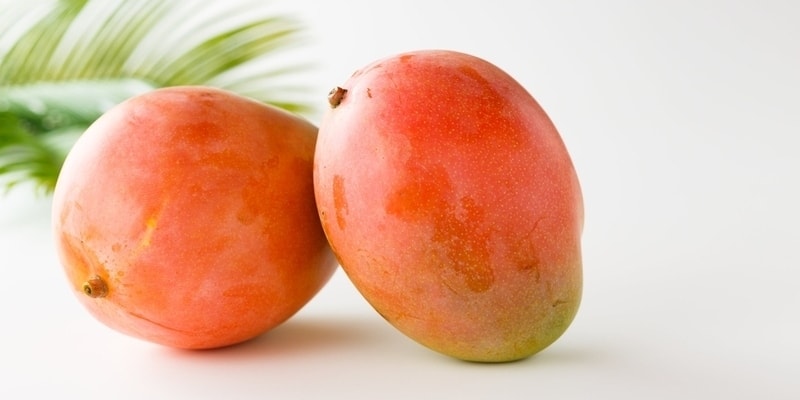
Also known as the Bowen mango, Kensington Pride is the most common and best-tasting mango in Australia.
It’s popular for its sweet, tangy flavour and strong mango aroma.
The Kensington mango boasts golden yellow skin and soft, juicy flesh.
Kensington Pride mango trees are vigorous growers. Leave them unpruned and you’ll end up with a tree that can reach up to 8m in height.
Their foliage forms a dense spreading canopy with purple and green leaves, perfect for creating shade in a spacious backyard.
While Kensington Pride is the most popular variety, growing these trees doesn’t come without challenges.
During phases of excessive growth, Kensington Pride trees tend to flower less, especially in the Northern Territory.
They are also known for their unpredictable fruit-bearing patterns and low-to-medium yield.
During cold weather, there is a low pollination rate for this variety.
R2E2 Mango
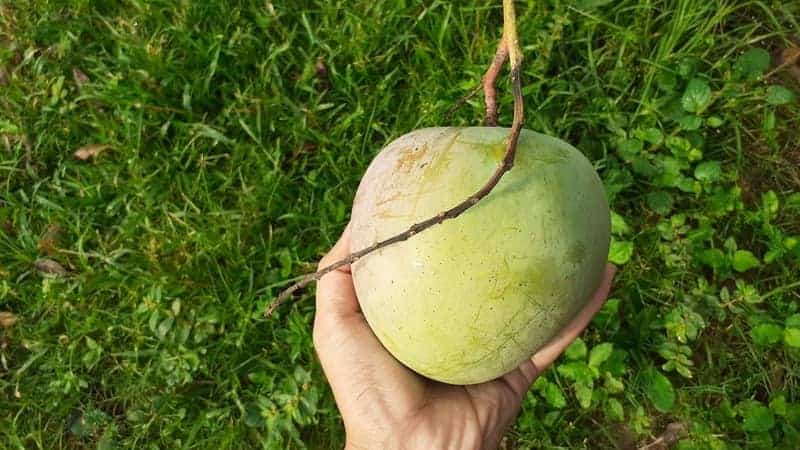
Larger than most mango varieties, the R2E2 mango is recognised for its bright red skin and sweet, mild flavour.
R2E2 mangoes are famous for their hefty-sized fruits, weighing 600g to 1kg apiece.
These mangoes are available from November through February.
It’s also well-loved for its long shelf life, which makes it a favourite among exporters.
Just like Kensington Pride, R2E2 trees are medium-to-highly vigorous growers.
Pruning regularly is a must during the early years to manage the tree’s height.
During the first two years of growth, prune your mango tree 2-3 times to maximise the fruit-bearing capacity of its branches.
Calypso Mango
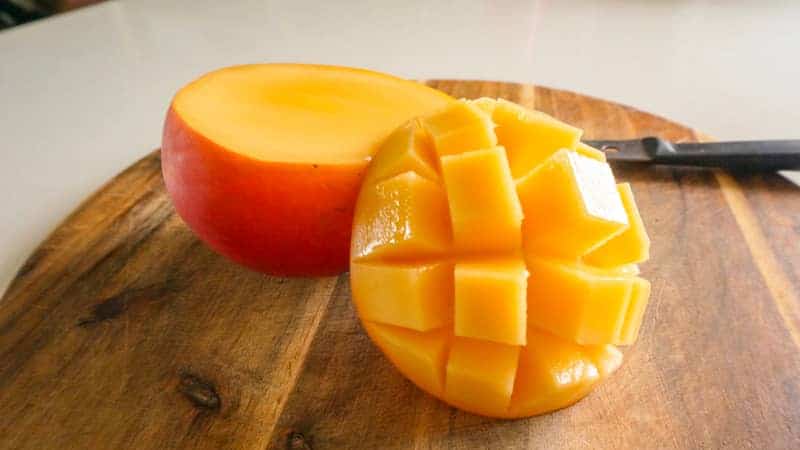
The Calypso mango is a pear-shaped fruit with deep orange skin.
It has minimal to no sap flow and is less prone to skin blemishes, ensuring it looks appealing on supermarket shelves.
When comparing the Calypso vs Kensington mango, the Calypso is sweeter and has a thinner seed, offering more flesh.
Calypso mangoes are not known to be vigorous growers. There’s an upside to this – you’ll need to prune less!
Trimming twice a year will keep your tree prepped for fruiting.
Unlike Kensington Pride mangoes which have an erratic fruiting pattern, Calypsos are pretty predictable.
Expect a 70kg fruit yield from an 8- to 9-year-old tree.
Honey Gold Mango

These mangoes are long, with thick skin and sweet, fibreless flesh.
The Honey Gold mango vs Kensington Pride comparison often favours the Honey Gold for its sweeter flavour, which becomes more intense later in the fruit-bearing season.
Honey Gold mangoes have an apricot-yellow colour and an intensely sweet taste.
These mangoes can be eaten fresh or frozen, with no stringy hairs that can get stuck between your teeth.
The first Honey Gold tree was bred by chance as a result of a Kensington Pride getting pollinated by an unknown variety.
The cultivar is relatively new but has already gained a following because of its delicious crop.
Mango Varieties Available Later in the Fruit-bearing Season
Brooks Mango
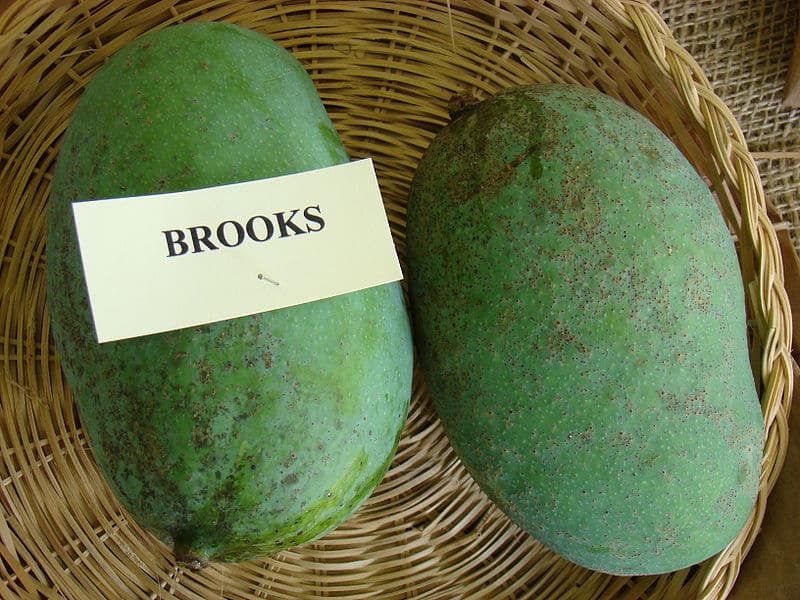
The Brooks mango is a late-season variety prized for its rich, sweet and aromatic flavour.
This variety boasts a large, elongated oval shape and skin that ranges from a blush red to a vibrant purple when fully ripe.
Its deep orange flesh is virtually fibreless, making it an excellent choice for fresh consumption or use in culinary creations.
Compared to other varieties, Brooks mango trees are relatively smaller.
It is a low-to-medium vigorous grower and has an upright, open canopy. 6-year-old trees can measure up to 2-4m in height.
Keitt Mango
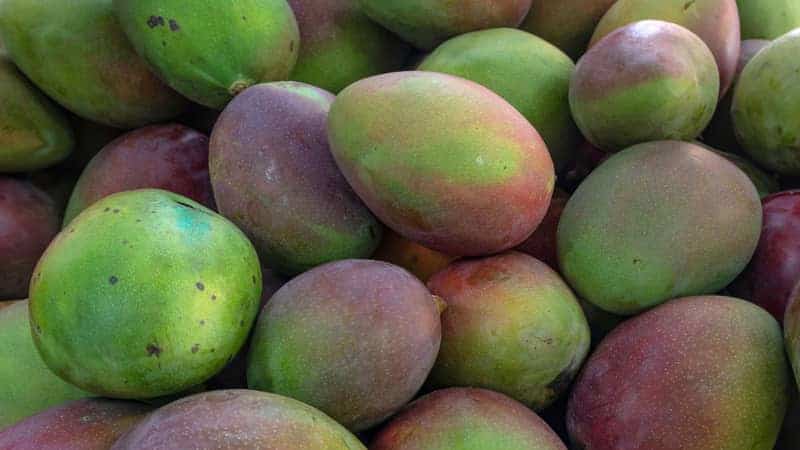
Originating from Florida, the Keitt Mango is one of the late-season mango varieties in Australia.
It is also grown commercially in other countries such as Mexico, USA, Israel, and South Africa.
This variety is propagated in sub-tropical and tropical regions in Australia and is available from January to March.
Keitt mangoes have a green-yellow skin colour tinged with a pink or bronze blush.
The fruit is quite large and weighs between 400g to 1kg apiece.
The Keitt is a semi-dwarf mango tree variety. It has an open, spreading shape that needs regular pruning during the first few years of growth.
It is less vigorous than other varieties and will take 4-6 years to mature and bear fruit well.
Kent mangoes
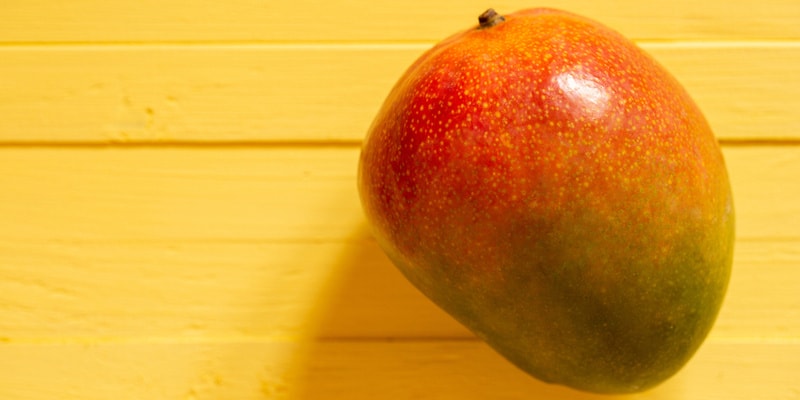
Kent mangoes are known for their broad-shouldered, ovate shape and rich, sweet, and juicy flesh.
Originating from Florida, they found a successful home in Australia due to their adaptability and disease-resistant nature.
The Kent mango has mostly dark green skin that may have a reddish-pink blush when ripe, contrasting with the deep yellow-to-orange flesh inside.
Kent trees are considered medium-sized and aren’t as vigorous as the Kensington Pride.
Regular pruning during the early stages of growth is necessary to build more fruiting terminals.
Palmer mango
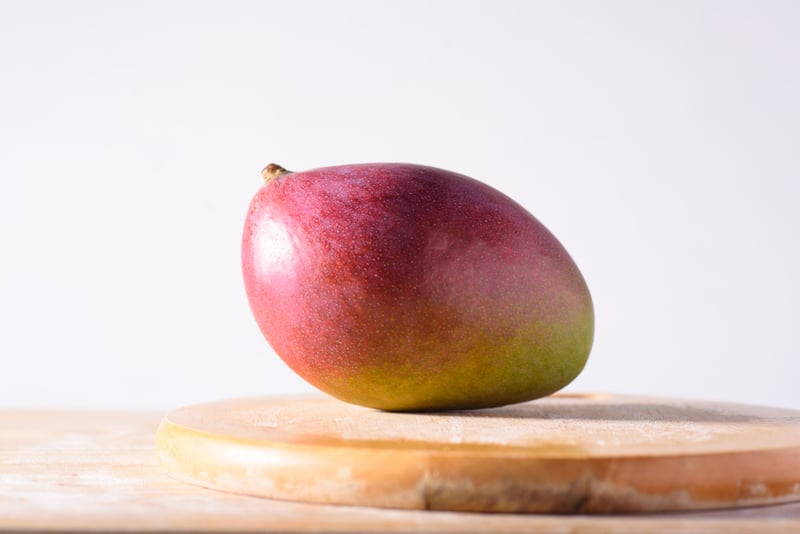
The first Palmer mangoes in Australia originated from Puerto Rico.
Nowadays, Queensland propagates Palmer mangoes commercially, but it is still considered a minor variety compared to the more popular cultivars.
These mangoes are available from January to March.
Known for its elongated shape and deep purple or red skin, the Palmer is an eye-catching fruit.
But it’s not just the colour that makes this mango popular; it has a delightful balance of tart and sweet flavour within its fibreless, juicy flesh.
The Palmer mango tree has an open and spreading canopy.
Pruning during the first few years of growth is a must to manage the tree’s shape and optimise its fruiting potential.
Pearl Mango
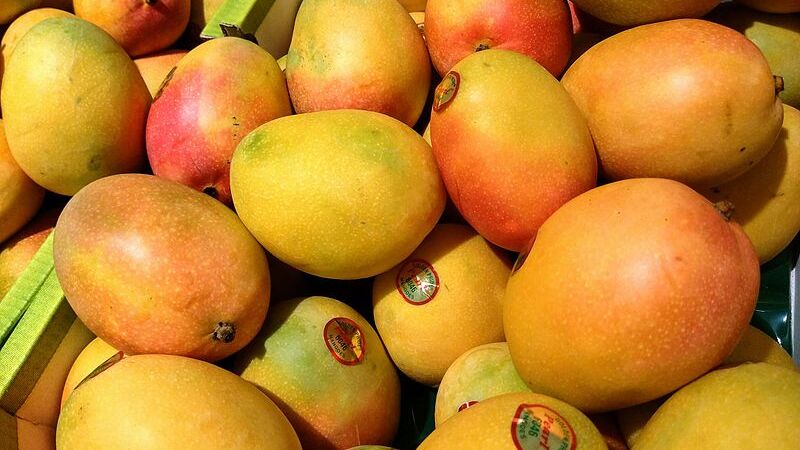
Pearl mangoes are juicy mangoes that got their name from their lovely pearl-flecked skin.
They are available through February.
Pearl mangoes are small to medium-sized with an ovate shape and deep orange skin.
Each fruit weighs between 300-400g. Pearls are known to be easy to work with in the kitchen because of their sweet, firm flesh.
Pearl mango trees are a late-maturing variety. As with other mango types, they need plenty of sun and soil with good drainage.
Mango tree care
Mango trees are not just producers of delicious tropical fruit — they’re also a gorgeous addition to any garden with their lush, tropical foliage.
Even if you’re a home grower, you can follow these tips to care for your mango trees like a pro gardener and ensure they thrive and yield abundant fruit year after year.
Selection and Planting
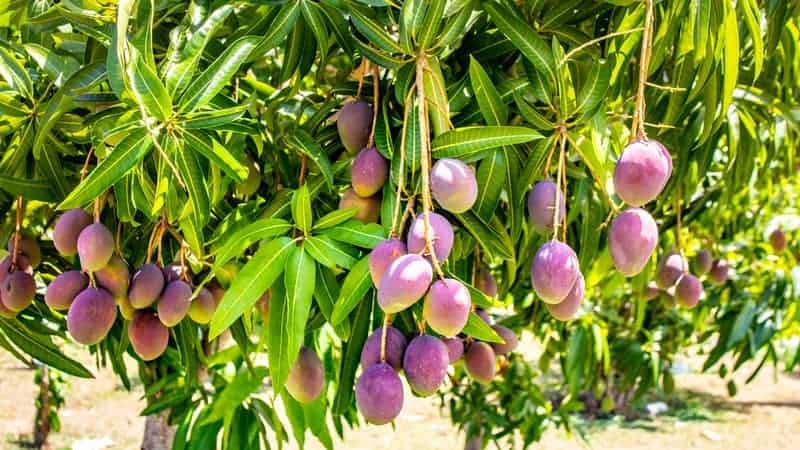
Start by choosing the right variety suitable for your region’s climate.
Mango trees prefer tropical and subtropical climates, but some varieties can tolerate cooler temperatures.
Make sure to plant the tree in a location with plenty of sunlight and enough space to grow.
Soil Requirements
Mango trees prefer well-drained, slightly acidic soil with a good balance of nutrients.
If your soil is heavy clay or too sandy, you might need to amend it with organic matter to improve its texture and fertility.
Watering
Young trees need regular watering, but mango trees are relatively drought-resistant once established.
Overwatering can lead to root rot and other fungal diseases. So, it’s best to let the soil dry out between waterings.
Fertilisation
Mango trees benefit from regular feeding. Use a balanced, slow-release fertiliser rich in nitrogen, phosphorus and potassium, or NPK fertilisers.
Feeding should be done in the growing season — usually spring and summer.
Pruning
Prune your mango tree in late winter or early spring before the growth flush.
This helps maintain a manageable size, improves tree structure, and encourages better fruit production.
Always remove dead, diseased, or crossing branches.
Pest and Disease Control
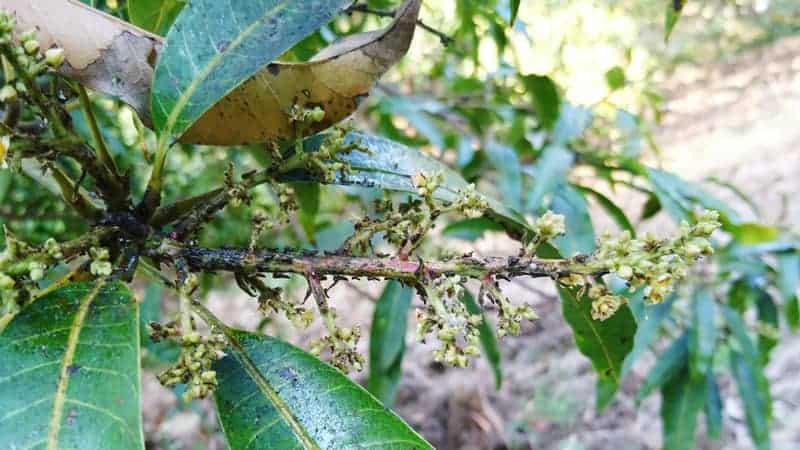
Watch for common pests like aphids, scale and mango fruit flies.
Diseases such as anthracnose and powdery mildew can also affect mango trees.
Regular inspection, using organic pesticides and proper sanitation practices can help manage these issues.
Harvesting
Mangoes generally ripen 100 to 150 days after flowering. The fruit is ripe when it slightly gives in to a gentle squeeze and exudes a fruity aroma from the stem end.
Of course, there are ways to ripen mangoes at home other than waiting and salivating until they have their vibrant yellow flesh colour.
Remember, patience is critical. Mango trees might take a few years to start producing fruit, but when they do, the taste of your home-grown mangoes will be worth the wait.
A Taste of Sunshine
From the famous Kensington Pride to the late-season Pearl, Australia is home to a range of delicious mangoes.
The sweetest mango in Australia is subjective as it depends on individual taste preferences.
However, many Aussies favour the Honey Gold and Calypso mangoes for their sugary, robust flavours.
With proper care and favourable conditions, these mango varieties can grace your garden and table with delectable fruits year after year.
The best part? They all contribute to Australia’s reputation for producing some of the world’s best mangoes.

